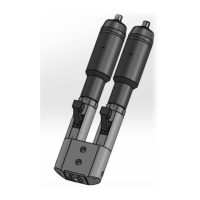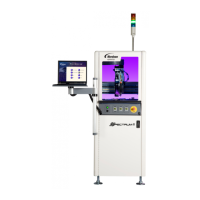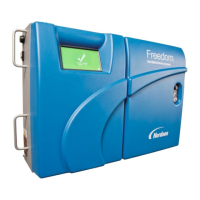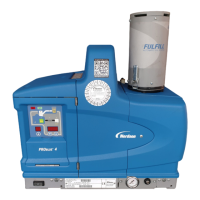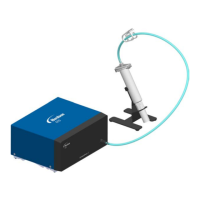G-2 Glossary
Dispensing Head: The robotic fluid applicator that
moves during the dispensing operation. The Dispensing
Valve, Height Sensor, Camera and Lighting, and
Dispense Head Controller are mounted on the
Dispensing Head. Sometimes referred to as the Z-Head.
Dispensing Runs (Wet/Dry): A wet dispensing run is
when fluid is dispensed. A dry run is when the program
is executed but no fluid is dispensed.
Dispensing Valve: A device used to control or regulate
the flow of material from a pressurized reservoir, such
as a syringe. These devices include Valves, Pumps, and
Jets.
DOAL: Diffuse On-Axis Light. Camera lighting
module that has both red and blue LEDs that enhance
image quality of the workpiece. Promotes rapid and
accurate identification of fiducials and other points of
reference on the workpiece.
Electrostatic Discharge (ESD): Discharge of a static
charge on a person’s body that travels through a
conductive path to ground. An electronic component
may suffer irreparable damage when it is exposed to the
static charge.
Emergency Shutdown: The dispensing system is
intentionally stopped to prevent injury to personnel or
damage to equipment. Shutdown is accomplished by
pushing the EMO button or switching off the Main
Circuit Breaker.
EMO: Emergency Off button on the front and back
panels of the dispensing system. Cuts power to the
dispensing system, but does not turn off power to the
Power Manager, Computer, or Monitor. Heater power is
interrupted, but the heaters can remain hot for some
time. Part of the Safety Interlock System.
ESD: See Electrostatic Discharge.
EU: European Union.
Fiducial: A distinct shape or object on the workpiece.
The Vision System uses fiducials for location reference.
Flip Chip Underfill: Dispensing lines of fluid around
the perimeter of a flip-chip so that the fluid flows
underneath the chip to seal and protect the connections.
Flip Chip: A die with solder bumps, placed with the
circuit side of the die facing downward on a PCB.
Flow Rate: Speed in milligrams per second that fluid
dispensed from the dispensing valve.
Fluid Air Regulator and Gauge: The Fluid Air
Regulator and Gauge set supplies air to the Precision
Fluid Air Regulator and Gauge Set.
Fluidmove for Windows XP (FmXP): Asymtek
proprietary dispensing software based in a Windows XP
environment.
Fluidmove Online Help: The help function in
Fluidmove that is accessed by clicking on the Help
button on most of the windows and dialog boxes on the
Monitor screen.
FmXP: See Fluidmove for Windows XP.
Front Panel: The machine/operator interface that
consists of system Start and Stop buttons and EMO
button.
FSL: Free-Standing Loader. A self-contained,
floor-mounted unit that transports a carrier or a
workpiece into or out of a dispensing system. The
Upstream FSL holds a full magazine of carriers, which
it feeds into the dispensing system. After the workpiece
has been processed, the Downstream FSL receives the
board or carrier into an empty magazine. FSL’s get their
instructions from programs created on the system
Computer with LoaderMove software.
Fuse: A safety device that is designed to automatically
cut off the flow of electricity when the flow of current
through the fuse exceeds its rated capacity.
Gauge: An analog or digital device used to measure
internal pressure of fluid or air in a closed system.
Genie Camera: The Dalsa-Coreco Genie M640
communicates bi-directionally to a host computer via
Gigabit Ethernet. No frame grabber is required. The
camera is configured to run at 60 full frames per second
which is twice as fast as the analog PCVision cameras.
A frame can be transferred in 16.67 milliseconds.
Graphic Card: Computer card that outputs the video
signal to the monitor.
Grounding Strap: A strap worn on the wrist of an
Operator and plugged into front panel jacks to prevent
an electrostatic discharge (ESD) that may cause damage
to the workpiece.
Heat Station Timers: Specify the time a part remains
in the pre-heat or post-heat zones.
Height Sensor: A device that measures substrate height
and sends a signal to the system computer. The height
information is used to position the dispensing needle at
an exact distance above the workpiece surface.
High Pressure Relief Valve: Safety feature designed to
prevent the dispensing system from being damaged if
the main air pressure is too high.
Home: The dispense head location whose X, Y, Z
location is defined as the coordinates (0,0,0). The
default setting is where the dispensing head was located
when the system was first turned on. On Asymtek
systems, the default home position is the front left hand
corner of the dispensing chamber.
I/O: Input/Output. Communication between one
component or device and another.

